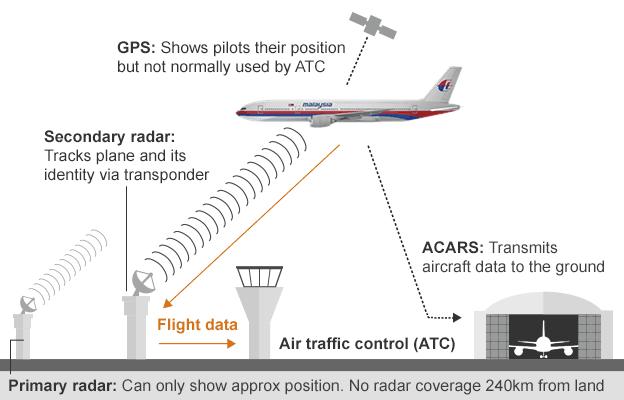Could this radar have spotted Malaysia's missing plane?
- Published
.jpg)
The new laser system could send live cockpit video as well as pinpoint a plane's precise location
As the search for the missing Malaysia Airlines flight intensifies, a new advanced radar system has been unveiled by scientists. But could it have spotted the plane?
The world's first photonic radar was tested at Pisa Airport in Italy and achieved "world-class" performance, according to an independent expert.
It uses lasers to produce high fidelity signals that pinpoint planes precisely.
But there are doubts over its range, say researchers in Nature journal, external.
Could it really have followed flight MH370 as it veered off its route from Kuala Lumpur to Beijing - possibly travelling far out over the southern Indian Ocean where search teams are now investigating sightings of possible debris?
Today's radar networks track planes via a combination of ground stations and satellites - as this guide explains.
Normal aircraft tracking

The new PhoDiR, external (Photonics-based fully digital radar) system is a working prototype for next-generation radars - designed to let pilots and air traffic control exchange far more information in a single signal.
Photonic systems promise:
Higher precision - less noise (interference) in the radar transmission
Higher bandwidth - able to transmit cockpit data (eg critical flight systems) as well as location data, simultaneously
Greater flexibility - more frequencies available
Smaller antennas - cheaper, lighter and more portable
PhoDiR was developed by Paolo Ghelfi and colleagues at Italy's National Laboratory of Photonic Networks.
To test their radar, they put it on the roof of their lab - and pointed it at planes taking off from nearby Pisa Airport.
"It was even more precise than we expected. We detected airplanes much farther away than we expected, with even higher precision," he told BBC Radio 4's Inside Science.
"We're still trying to find out exactly how much better it is than conventional radar. It's only a prototype - we don't have clear numbers yet."
The compact system could potentially be installed on aircraft, and has a very large bandwidth - allowing pilots to transmit detailed information directly to ground stations within range.
"In future, we imagine a system on an airplane that can scan objects around but also communicate what's happening in the cockpit - what has been said, movements in the airplane, everything," Dr Ghelfi told BBC News.
"One could imagine transmitting live streaming video, together with the radar surveillance data. The advantage would be that a single system can do the entire job, instead of multiple systems."

Experts say photonic radar can overcome some of the limitations of current electronic systems.
A laser produces a finely-tuned digital signature, which is converted into a radio frequency wave and transmitted from the radar antenna.
The returning wave is also converted via laser into a digital signal free from "jitter".
"Because the light is very precise, so is the radio frequency signal," said Prof David Stupples, an expert on radar systems at City University in London.
"Currently we produce the carrier wave using electronics. But then you've got to transport it up to the radar head through expensive, heavy cabling - and this creates noise in the system.
"But if you use light - with fibre optics - it is cheaper, lighter and crucially - it has less interference. It's very accurate."
The BBC's Richard Westcott takes a look at the technology used to track a plane in flight
Jason McKinney, of the US Naval Research Laboratory, said the performance of the system's transmitter and return signal converter were "world-class with respect to those of other photonics-based devices".
"These elements... are appealing components for future frequency-agile, software-defined radar architectures," he wrote in a commentary in Nature.
The main limitation on the system, he says, is range. It's not clear how a photonic ground radar could cover any greater swathe of ocean than current coastal stations.
Dr Ghelfi agrees. "Over oceans you might still depend on satellite capacity," he told BBC News.
And for this reason, the missing Malaysia Airlines flight MH370 would likely evade PhoDiR too - assuming it has taken a path across the Indian Ocean.
Rather than hunting planes over seas, the new system would be much more useful over land - benefiting European air traffic control for instance, the researchers suggest.
In highly-congested airspaces - such as above London's Heathrow Airport - pilots will know precisely how much breathing space they have.
But the photonic system could also have applications beyond air traffic control.
It could be used more widely in surveillance and wireless communications. Dr Stupples even suggests it could help motorway drivers to avoid collisions in fast-moving traffic.
"We are putting all these radar systems into a single small chip - low-cost with multiple functionalities," said Dr Ghelfi.
"But it will not be something that you will see right away - we are in the range of years and not of months."